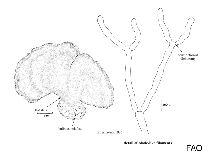Tydemania expeditionis Weber-van Bosse
Green sea beads| Native range | All suitable habitat | Point map | Year 2050 |

|
| This map was computer-generated and has not yet been reviewed. |
| Tydemania expeditionis AquaMaps Data sources: GBIF OBIS |
Google image | No image available for this species;
drawing shows typical species in Udoteaceae.
Classification / Names Common names | Synonyms | CoL | ITIS | WoRMS
Bryopsidophyceae | Bryopsidales | Udoteaceae
Environment: milieu / climate zone / depth range / distribution range Ecology
Sessile; depth range 0 - 50 m (Ref. 102147). Tropical
Distribution Countries | FAO areas | Ecosystems | Occurrences | Introductions
Indian Ocean: in Tanzania, Amirante Islands and Seychelles, east to India including Maldives and Chagos Archipelago; in Andaman and Nicobar Islands; Pacific Ocean: from China to the South China Sea, south to Queensland, Australia, including Spermonde Archipelago, Guam, Federated States of Micronesia, Marshall Islands, Solomon Islands, Fiji, and Lord Howe Island, east to American Samoa.
Length at first maturity / Size / Weight / Age
Maturity: Lm ? range ? - ? cm
Short description Morphology
Life cycle and mating behavior Maturity | Reproduction | Spawning | Eggs | Fecundity | Larvae
Main reference
References | Coordinator | Collaborators
Guiry, M.D. and G.M. Guiry 2009 AlgaeBase. World-wide electronic publication, National University of Ireland, Galway. http://www.algaebase.org; searched on 14 April 2009. (Ref. 80701)
IUCN Red List Status
(Ref. 130435: Version 2025-1)
CITES status (Ref. 108899)
CMS (Ref. 116361)
Threat to humans
Human uses
| FishSource |
Tools
More information
Diet composition
Food consumption
Predators
Max. ages / sizes
Length-weight rel.
Length-length rel.
Length-frequencies
Mass conversion
Abundance
Maturity
Fecundity
Spawning
Eggs
Egg development
Larvae
Internet sources
BHL | BOLD Systems | CISTI | DiscoverLife | FAO(Publication : search) | Fishipedia | GenBank (genome, nucleotide) | GloBI | Gomexsi | Google Books | Google Scholar | Google | PubMed | AlgaeBase | Tree of Life | Wikipedia (Go, Search) | Zoological Record



